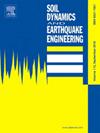Out-of-plane mechanical behavior and theoretical analysis of concealed column timber frame infill wall
IF 4.2
2区 工程技术
Q1 ENGINEERING, GEOLOGICAL
引用次数: 0
Abstract
The traditional dwellings feature thick infill wall (IW) with timber frames (TF) embedded within, forming a concealed column timber frame infill wall (TF-IW) system. Due to the lack of effective tensioning between the concealed column TF and IW, the IW is prone to out-of-plane (OOP) collapse under seismic action. To improve the connection performance between the TF and IW, a reinforcement method using embedded reinforcement element was proposed and designed. Four groups of 1:2 scale concealed column TF-IW specimens were designed, with the number and position of embedded reinforcement element as parameters. By studying the mechanical properties and deformation characteristics of each specimen, the arrangement principles of the embedded reinforcement element were determined. Additionally, the mechanical properties and deformation characteristics of the concealed column TF-IW were further studied using ABAQUS software. Based on this, a simplified calculation model for the bearing capacity (OOP) of IW was established, considering factors such as crack height, IW thickness, IW width, mortar strength, and boundary conditions. The results show that the calculation results are in excellent agreement with the experimental results. The study indicates that the mortar strength and the constraint effect of the beam on the IW have a minor impact on the bearing capacity (OOP) of the IW, increasing it by 9.3 % and 2.4 %, respectively, while the constraint effect of the TF column on the IW and the height of the cracks in the IW have a significant impact, increasing the bearing capacity by 69.7 % and 34.4 %, respectively. The research findings can provide a theoretical basis for the reinforcement design of concealed column TF-IW.
隐柱木框架填充墙的面外力学行为及理论分析
传统民居的特点是厚填充墙(IW)内嵌木框架(TF),形成隐柱木框架填充墙(TF-IW)系统。在地震作用下,由于隐蔽柱TF与内墙之间缺乏有效张拉,内墙容易发生面外倒塌。为了提高桥架与桥架之间的连接性能,提出并设计了一种采用嵌入式加固单元的加固方法。设计了4组1:2比例尺隐柱TF-IW试件,以预埋钢筋单元的数量和位置为参数。通过对各试件力学性能和变形特性的研究,确定了预埋配筋单元的布置原则。此外,利用ABAQUS软件对TF-IW隐伏柱的力学性能和变形特性进行了进一步研究。在此基础上,考虑裂缝高度、接缝厚度、接缝宽度、砂浆强度、边界条件等因素,建立了接缝承载力的简化计算模型。结果表明,计算结果与实验结果吻合良好。研究表明,砂浆强度和梁对墙墙承载力的约束作用对墙墙承载力的影响较小,分别提高9.3%和2.4%,而墙墙柱对墙墙的约束作用和墙墙裂缝高度的影响较大,分别提高了69.7%和34.4%。研究结果可为TF-IW隐伏柱的配筋设计提供理论依据。
本文章由计算机程序翻译,如有差异,请以英文原文为准。
求助全文
约1分钟内获得全文
求助全文
来源期刊

Soil Dynamics and Earthquake Engineering
工程技术-地球科学综合
CiteScore
7.50
自引率
15.00%
发文量
446
审稿时长
8 months
期刊介绍:
The journal aims to encourage and enhance the role of mechanics and other disciplines as they relate to earthquake engineering by providing opportunities for the publication of the work of applied mathematicians, engineers and other applied scientists involved in solving problems closely related to the field of earthquake engineering and geotechnical earthquake engineering.
Emphasis is placed on new concepts and techniques, but case histories will also be published if they enhance the presentation and understanding of new technical concepts.
 求助内容:
求助内容: 应助结果提醒方式:
应助结果提醒方式:


